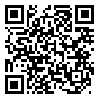Volume 11, Issue 4 (12-2021)
J Health Saf Work 2021, 11(4): 737-750 |
Back to browse issues page
Download citation:
BibTeX | RIS | EndNote | Medlars | ProCite | Reference Manager | RefWorks
Send citation to:



BibTeX | RIS | EndNote | Medlars | ProCite | Reference Manager | RefWorks
Send citation to:
Babaei-Pouya A, Pajohideh Z, Feiz Arefi M. Identification and risk assessment of midwife error in the labor using systematic human error reduction and prediction approach. J Health Saf Work 2021; 11 (4) :737-750
URL: http://jhsw.tums.ac.ir/article-1-6585-en.html
URL: http://jhsw.tums.ac.ir/article-1-6585-en.html
1- Ardabil University of Medical Sciences, Department of Occupational Health Engineering, School of Health, Ardabil University of Medical Sciences, Ardabil, Iran
2- Department of occupational Health Engineering, School of Health, Torbat Heydariyeh University of Medical Sciences, Torbat Heydariyeh, Iran | Health Sciences Research Center, Torbat Heydariyeh University of Medical Sciences, Torbat Heydariyeh, Iran
2- Department of occupational Health Engineering, School of Health, Torbat Heydariyeh University of Medical Sciences, Torbat Heydariyeh, Iran | Health Sciences Research Center, Torbat Heydariyeh University of Medical Sciences, Torbat Heydariyeh, Iran
Abstract: (1565 Views)
Introduction: Labor is one of the most important wards of hospital, where human error is high. Midwifery errors in the maternity ward and in the delivery can be a serious threat to the health of the mother and the infant, resulting in increased treatment costs. Factors affecting human error are diversity in work, high workload, and fatigue. Therefore, this study aimed to evaluate the midwifery errors in the maternity ward using the systematic human error reduction and prediction approach (SHERPA) technique.
Material and Methods: This cross-sectional study was conducted in 2019, during which different midwifery tasks were determined in four stages of admitting, pre-labor, delivery, and postpartum. Tasks and sub-tasks were identified using the hierarchical task analysis (HTA) technique and human error was evaluated using the SHERPA technique.
Results: The results of the HTA technique identified 19 main tasks, 52 sub-tasks, and 114 activities. After assessing human error risk with the SHERPA technique, the performance was the most frequent type of error and the highest frequency was related to the undesirable risk level.
Conclusion: The errors of the midwifery profession in the hospital’s labor are high-risk and largely critical. Factors such as high workload, time pressure, and fatigue influence the incidence of human error. In order to reduce human error in this area, strategies such as reducing staff workload, developing standard checklists and guidelines are essential to reduce human error in this ward.
Material and Methods: This cross-sectional study was conducted in 2019, during which different midwifery tasks were determined in four stages of admitting, pre-labor, delivery, and postpartum. Tasks and sub-tasks were identified using the hierarchical task analysis (HTA) technique and human error was evaluated using the SHERPA technique.
Results: The results of the HTA technique identified 19 main tasks, 52 sub-tasks, and 114 activities. After assessing human error risk with the SHERPA technique, the performance was the most frequent type of error and the highest frequency was related to the undesirable risk level.
Conclusion: The errors of the midwifery profession in the hospital’s labor are high-risk and largely critical. Factors such as high workload, time pressure, and fatigue influence the incidence of human error. In order to reduce human error in this area, strategies such as reducing staff workload, developing standard checklists and guidelines are essential to reduce human error in this ward.
Type of Study: Research |
Received: 2021/12/24 | Accepted: 2021/12/31 | Published: 2021/12/31
Received: 2021/12/24 | Accepted: 2021/12/31 | Published: 2021/12/31
| Rights and permissions | |
 |
This work is licensed under a Creative Commons Attribution-NonCommercial 4.0 International License. |






